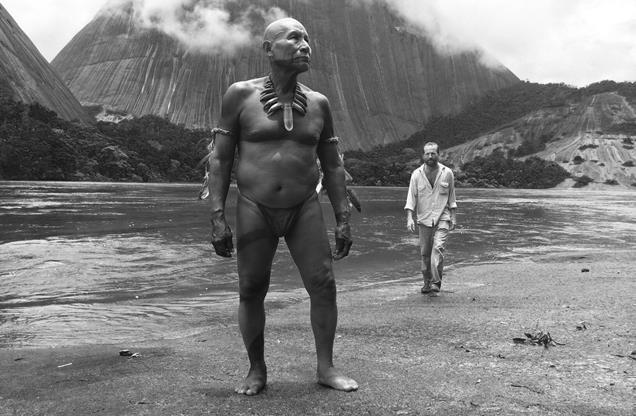Embrace of the Serpent (Ciro Guerra, 2016): Colombia, Venezuela, Argentina
Reviewed by Phill Hunziker. Viewed at the Chinese Theater, part of the AFI Film Festival 2015.

Columbia’s official submission to the Oscar’s for Best Foreign Film has a genuine chance in receiving the nomination. The filmmakers received a standing ovation in its first screening at AFI Fest; I’d say it was well deserved.
The narrative holds two separate timelines that cut back and forth as they both progress. The first timeline (1909) follows ill scientist Theodor Koch-Grunberg (Jan Bijvoet) as he searches the Amazon for yakruna, a sacred plant that has the potential to save his life. The second timeline (1940) follows scientist Richard Evans Schultes (Brionne Davis) as he too searches for yakruna, but as a means to achieve greater knowledge/understanding. Both are assisted by Karamakate, a cynical native who denounces all western influence in his lands. Young Karamakate (Nilbio Torres) reluctantly helps Theodor while Old Karamakate (Antonio Bolívar) assists Richard in hope that he can reconnect and remember spiritually. Each of their journeys cover the same path as the actions of the former adventurers have effects on the latters’ journey.
The narrative is character-driven, as their arcs are the main points of focus for the narrative. However, the stunning world in which the narrative takes place is where the true beauty lies. The decision to capture the events in black and white was the correct one, as it dates the film to the past and provides a filter that ultimately sets the tone for the film. Coupling that with the authentic wardrobe and props further pushes that retro feel. However, adding in the dizzying-yet-clear cinematography establishes a world and time of its own. Long takes make up the majority of the film, allowing for nature and humanity to remain on display. The camera moves slowly through the jungle with elegance, establishing dramatic sense-pounding tension when combined with its dark, powerful score. The lighting is significant, as it is almost entirely natural. The daytime lighting goes well with the black and white filter, as it fills the screen with an equal amount of natural beauty, rather than highlighting certain aspects of the mise-en-scene. The nighttime lighting consists of mainly fire-generated light that both allows for a personal connection with the characters to be established and creates the stimulating signs of a crackling fire. That sound, much like the crickets and natural sounds of the forests fill the gaps between events and dialogue, revolutionizing the idea of silence. Rather than simply being the absence of sound, the film presents silence as tranquility and unity with nature. The natural setting and focus on humanity and natural ideologies establishes a grand sense of realism while the filmmakers utilize surrealistic techniques (there’s some trippy stuff) to elaborate on its presented ideas.
There is no clear cut right and wrong spectrum/philosophy established. The native vs. 1st world battle exchanges ideological blows, proving both ideologies to be both flawed and plausible. Karamakate’s cynicism towards ‘the whites’ is just, but the rejection of intellectual advancement is not. Both Theodor and Richard look to learn from the native culture, but have a hard time shedding their baggage and idiosyncrasies carried over from their civilized lives. Additionally, tho motives of the explorers are tested. Are these explorers looking for answers for the betterment of society or so that they themselves find solace in knowledge and experience? Possibly both, the evolution and deconstruction of both of them overtime shows them each gradually shift to opposite ends of that scale. Theodore shifts more towards selflessness, truly dedicating himself to the betterment of society. Meanwhile Richard, while well-intentioned, seems to be more interested spiritual cleansing and improved understanding for himself at the end of the day. Overall, the film tackles many ideological differences between multiple cultures, raising more questions than answers. That, though, is the beauty of the film. True peace and understanding come from the journey, rather than the end result. Embrace of the Serpent is quite the journey.
About this entry
You’re currently reading “Embrace of the Serpent (Ciro Guerra, 2016): Colombia, Venezuela, Argentina,” an entry on Student Film Reviews
- Published:
- 11.17.15 / 5pm
- Category:
- AFI Filmfest 2015, Films
No comments
Jump to comment form | comments rss [?]